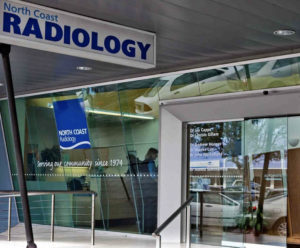Bone Densitometry
Using Dual Energy X-ray Absorption (DEXA), this examination is used to measure Bone Mineral Density (BMD). The most common cause for loss of bone density is osteoporosis.
Given that women lose bone from about the age of 45 (linked with Oestrogen production falling), a Bone Density Scan that enables a like for like comparison over time is useful to alert patients and provide time for them to minimise risks of Osteoporosis.
Information about Osteoporosis can be found at the Osteoporosis Australia website here.
The Health Direct Website provided by the Australian Federal Government is also worth reading; Search for Osteoporosis here.
While there is no specific preparation required for this examination, patients must bring their previous examination films/images from other providers and even if we did the previous Bone Density examination. This is important to help our Radiographers plan where the scanning lines will be located.
A thin beam of x-ray energy is passed through the lower spine and hip regions. A computer calculates how much of x-ray energy is absorbed by the bones and compares the results with what is expected in a young (20 year old) person, and also with what is expected for a person of your age, sex and race. The results are plotted on a graph, and a report given by the radiologist.
The result will be given as a T-Score where a result > -1 is normal, a score between -1 and -2.5 would mean Osteopenia and a score below -2.5 would mean Osteoporosis.
The use of consistent scanning protocols and equipment help deliver a more valuable picture for patients.
The Government uses rules to determine if rebates offered by Medicare and the Department of Veterans Affairs can be accessed by patients. To be eligible for such a rebate patients must meet one of the following criteria, and such criteria must be indicated on the referral, ideally with the relevant Medicare item Number.
Summary of Medicare Eligible Bone Density Examinations effective 1 Nov 2017
Item Number 12306
One service only in a 24 month period if performed for:
- Confirmation of a presumptive diagnosis of low bone mineral density made on the basis of one or more factures occurring after minimal trauma. Can only be used once for each fracture; or
- Monitoring of osteoporosis proven by previous bone densitometry at least 12 months previously;
- Scan at least 2 years prior with Z score of -1.50 or lower, or T score of -2.50 or lower.
Item Number 12312
One service only in a 12 month period if performed for:
- Prolonged and current glucocorticord therapy (as per dose limits outlined in the MBS);
- Conditions associated with excess glucorticoid secretion;
- Male hypogonadsim; or
- Female hypogonadism lasting more than 6 months before the age of 45 years.
Item Number 12315
One service only in a 24 month period if performed for diagnosis and monitoring of bone loss associated with one or more of the following:
- Primary hyperparathyroidism;
- Chronic liver disease;
- Chronic renal disease;
- Proven malabsorptive disorders (e.g. Coeliac or Crohn’s disease);
- Rheumatoid arthritis; or
- Conditions associated with thyroxine excess.
Item Number 12321
If performed 12 months following a significant change in therapy for established low bone mineral density. (Change in class of drugs rather than change in dose regime, or confirmation of a presumptive diagnosis of low bone mineral density made on the basis of 1 or more fractures occurring after minimal trauma.)
Patients over 70 yrs:
Bone densitometry, using dual energy X‑ray absorptiometry or quantitative computed tomography, involving the measurement of 2 or more sites (including interpretation and reporting) for the measurement of bone mineral density, in a patient aged 70 years or over if:
Item Number 12320
(a) the patient has not had previous bone densitometry testing; or
(b) the patient has bone mineral density as measured by a t‑score of ‑1.5 or above; other than a service associated with a service to which item 12306, 12312, 12315, 12321 or 12322 applies For any particular patient, once only in a 5 year period.
Item Number 12322
(a) the patient is 70 years of age or over; and
(b) the patient has bone mineral density as measured by a t‑score of less than between ‑1.5 or above ‑2.5; other than a service associated with a service to which item 12306, 12312, 12315, 12320 or 12321 applies For any particular patient, once only in a 2 year period.
Routine Bone Mineral Density Measurement
Includes all other indications. No Medicare Benefit is applicable. Our normal fee applies.
Please contact us if you require further information. Please note that information regarding Medicare Eligibility is determined by the Federal Government. As such, this information may change. Please contact your local NCRG branch for current information.
Patient informations sheet to come
Using Dual Energy X-ray Absorption (DEXA), this examination is used to measure Bone Mineral Density (BMD). The most common cause for loss of bone density is osteoporosis.
Given that women lose bone from about the age of 45 (linked with Oestrogen production falling), a Bone Density Scan that enables a like for like comparison over time is useful to alert patients and provide time for them to minimise risks of Osteoporosis.
Information about Osteoporosis can be found at the Osteoporosis Australia website here.
The Health Direct Website provided by the Australian Federal Government is also worth reading; Search for Osteoporosis here.
While there is no specific preparation required for this examination, patients must bring their previous examination films/images from other providers and even if we did the previous Bone Density examination. This is important to help our Radiographers plan where the scanning lines will be located.
A thin beam of x-ray energy is passed through the lower spine and hip regions. A computer calculates how much of x-ray energy is absorbed by the bones and compares the results with what is expected in a young (20 year old) person, and also with what is expected for a person of your age, sex and race. The results are plotted on a graph, and a report given by the radiologist.
The result will be given as a T-Score where a result > -1 is normal, a score between -1 and -2.5 would mean Osteopenia and a score below -2.5 would mean Osteoporosis.
The use of consistent scanning protocols and equipment help deliver a more valuable picture for patients.
The Government uses rules to determine if rebates offered by Medicare and the Department of Veterans Affairs can be accessed by patients. To be eligible for such a rebate patients must meet one of the following criteria, and such criteria must be indicated on the referral, ideally with the relevant Medicare item Number.
Summary of Medicare Eligible Bone Density Examinations effective 1 Nov 2017
Item Number 12306
One service only in a 24 month period if performed for:
- Confirmation of a presumptive diagnosis of low bone mineral density made on the basis of one or more factures occurring after minimal trauma. Can only be used once for each fracture; or
- Monitoring of osteoporosis proven by previous bone densitometry at least 12 months previously;
- Scan at least 2 years prior with Z score of -1.50 or lower, or T score of -2.50 or lower.
Item Number 12312
One service only in a 12 month period if performed for:
- Prolonged and current glucocorticord therapy (as per dose limits outlined in the MBS);
- Conditions associated with excess glucorticoid secretion;
- Male hypogonadsim; or
- Female hypogonadism lasting more than 6 months before the age of 45 years.
Item Number 12315
One service only in a 24 month period if performed for diagnosis and monitoring of bone loss associated with one or more of the following:
- Primary hyperparathyroidism;
- Chronic liver disease;
- Chronic renal disease;
- Proven malabsorptive disorders (e.g. Coeliac or Crohn’s disease);
- Rheumatoid arthritis; or
- Conditions associated with thyroxine excess.
Item Number 12321
If performed 12 months following a significant change in therapy for established low bone mineral density. (Change in class of drugs rather than change in dose regime, or confirmation of a presumptive diagnosis of low bone mineral density made on the basis of 1 or more fractures occurring after minimal trauma.)
Patients over 70 yrs:
Bone densitometry, using dual energy X‑ray absorptiometry or quantitative computed tomography, involving the measurement of 2 or more sites (including interpretation and reporting) for the measurement of bone mineral density, in a patient aged 70 years or over if:
Item Number 12320
(a) the patient has not had previous bone densitometry testing; or
(b) the patient has bone mineral density as measured by a t‑score of ‑1.5 or above; other than a service associated with a service to which item 12306, 12312, 12315, 12321 or 12322 applies For any particular patient, once only in a 5 year period.
Item Number 12322
(a) the patient is 70 years of age or over; and
(b) the patient has bone mineral density as measured by a t‑score of less than between ‑1.5 or above ‑2.5; other than a service associated with a service to which item 12306, 12312, 12315, 12320 or 12321 applies For any particular patient, once only in a 2 year period.
Routine Bone Mineral Density Measurement
Includes all other indications. No Medicare Benefit is applicable. Our normal fee applies.
Please contact us if you require further information. Please note that information regarding Medicare Eligibility is determined by the Federal Government. As such, this information may change. Please contact your local NCRG branch for current information.
Patient informations sheet to come







